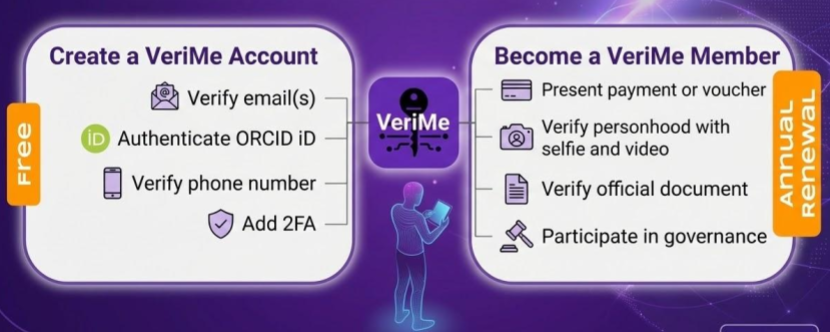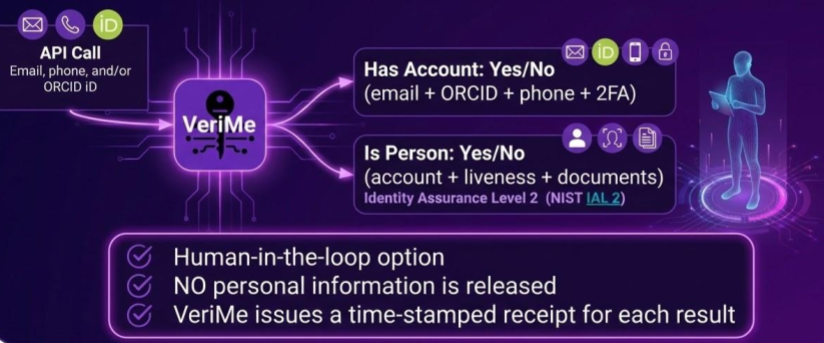How VeriMe Works
Validate Without Friction
In research and scholarship, access to tools, data, and funding often depends on proving who you are and what you’re qualified to do. But verification shouldn’t slow you down.
VeriMe makes the process transparent, privacy-preserving, and under your control.
At its core, VeriMe helps you verify your identity once and re-use everywhere — confirming your identity and credentials across research workflows without the repetitive forms or delays. It’s like having a trusted colleague vouching that your digital identity really belongs to you, without needing to share your sensitive information with everyone!”
Registering for a VeriMe Account
To create a VeriMe account, you will need access to the Internet, a mobile phone with text/SMS capability, and a webcam on your phone or computer. We are a researcher service, so we also ask that all account holders have an ORCID account.
For no fee, researchers can create an account and link and verify their email account(s), mobile phone number, and ORCID iD, and secure that account with multi-factor authentication (2FA). Researchers who become VeriMe Cooperative members can also prove their personhood and verify their identity, as well as participate in VeriMe governance. Learn more about Membership.
Evidence Markers
Today, VeriMe enables two Verifications: Is this a valid VeriMe account, and has the person controlling the account provided proof of personhood. These Verifications are based on the following evidence markers:
Account security: Have you validated your email address and phone number? Have you secured your account using multi-factor authentication?
Linked account. Have you linked and validated at least one external account? Since VeriMe is focused on research and scholarship, our recommended linked account is ORCID.
Personhood. Have you provided a physical identification document that has been validated? Have you demonstrated that you are a living person (and not a photo of a person, or an AI bot)?
Uniqueness. Has the information you have provided been attached to exactly one VeriMe account?
Each evidence marker is converted into a yes/no statement. You, as a VeriMe account holder, may view the evidence you have already provided and validated. You can also see what evidence may be missing and how to provide it.
The VeriMe platform is extendable! We welcome your ideas for other Evidence Markers that would be useful for research and scholarship.
VeriMe Account Information remains private.
VeriMe does not expose the sensitive evidence that you provide. Rather, we convert Evidence Markers into yes/no statements and bundle them into Verification values.
VeriMe provides none of your sensitive evidence used to calculate the Verification value.
VeriMe maintains account audit logs enabling us to reproduce a Verification value as it was on a specific date and time — giving confidence without exposing private details. We also log every request for Verification values sent to your Account.
Verification Requests
Subscribers may integrate VeriMe services into their products and services to incorporate Verification values into research and scholarship workflows. These integrations make it easy for you to prove you are who you say you are and they empower researchers and organizations alike to cooperate in creating an accountable research environment.
Learn more about Subscriptions.
Subscribers may request Validation values that are associated with information that they know, for example, an authenticated ORCID iD or a verified email address or phone number. You are in control of the availability of your Verifications (see below). The Verifications you decide to make available will be available to Subscribers through a system-to-system interface called an API (Application Programming Interface).
Examples of Verification requests:
API Request: What is the status of the VeriMe Account with this ORCiD ID?
VeriMe Response: IsValid
API Request: Is the VeriMe account with this email address held by a person?
VeriMe Response: IsPerson
API Request: What is the birthdate for a person with this name?
VeriMe Response: Unavailable (VeriMe does not provide this type of information)
You are in control
You decide what evidence to provide and validate. You control whether your account verification values are visible to subscribers. And you can change your mind at any time.
VeriMe provides transparent information about who has requested information about you, when, and what VeriMe provided as a response.
You control more than your data!
When you become a Member and user of the VeriMe platform you not only have the peace of mind that privacy and control of your personal data will be in your hands, but you also become part of the governance over the significant decisions that the organization may face - should sharing rules be adjusted, and if so, in what ways? Should this organization be restricted in the way that they use the service? The organization has a surplus this year, what percentage should be reinvested into new VeriMe services?
VeriMe is a trust-enabler, not a gatekeeper — a shared language of trust for the research ecosystem.

